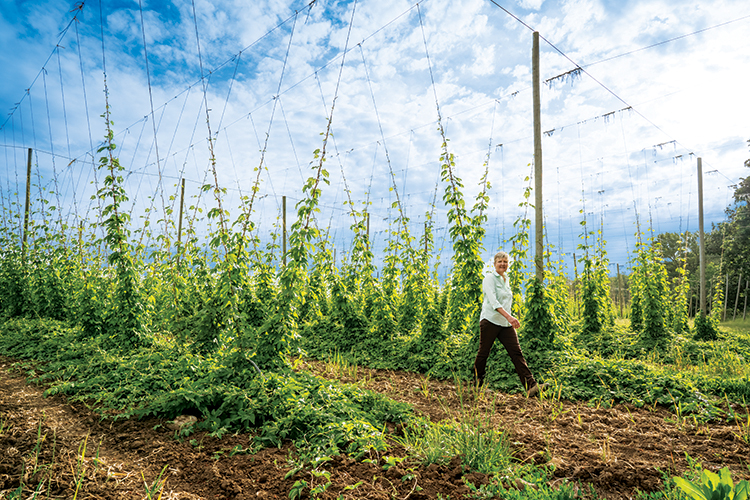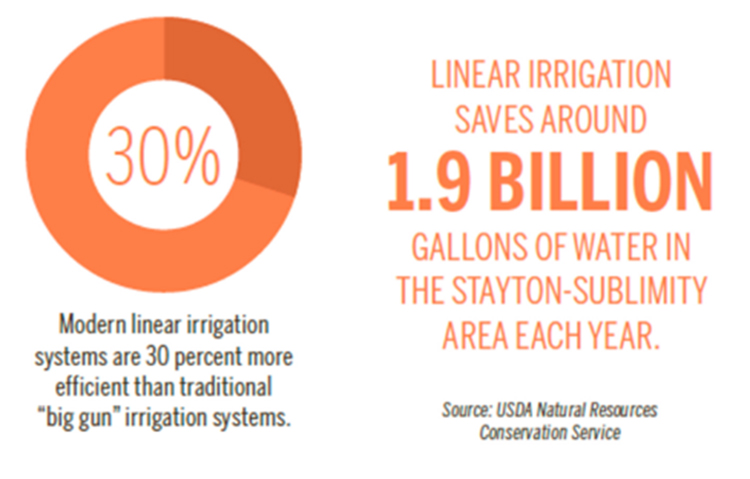Home > Oregon > Oregon Environment > Irrigation Innovation on Oregon Farms
Irrigation Innovation on Oregon Farms

First came the transition from overhead sprinkler irrigation to drip. Then the benefits started pouring in.
By watering only where and when their hops plants need it, Gayle and Glenn Goschie, a brother-and-sister team that runs Goschie Farms in Silverton, found their water and fertilizer applications have decreased; weed, insect and disease pressure has been reduced; and their yields have improved.
The Goschies are among hundreds of Oregon farmers reaping the benefits of using less water and power after transitioning from high-pressure overhead sprinkler systems to drip and linear systems.
Ironically, though, it wasn’t a desire to lower water use and increase productivity that drove the Goschies to switch irrigation systems. It was the finicky nature of hops they wished to grow.
“We were looking at growing a variety of hops that was, unfortunately, susceptible to downy mildew,” Gayle says.
Downy mildew, it turns out, flourishes in high humidity, so the Goschies looked for ways to reduce the humidity they were bringing into the field.
 Dripping with Benefits
Dripping with Benefits
“The beautiful spring rains, we can’t control those,” Gayle says. “But in changing from sprinkler irrigation to drip irrigation, we removed the humidity that would have been placed into that planting through the summer and close to the fall harvest season.
“Then we started to see other advantages,” she says. “By only putting water to the plants and not irrigating that whole parcel of land, we found the amount of trips we needed to make through the field to cultivate the weeds were reduced, because the weeds weren’t popping back up every time we irrigated.”
Also, because the system allowed them to spoon feed liquid nutrients to plants through the drip lines, the farm was able to refine the delivery of nutrients to better meet plant needs.
“A gentleman I know had a good analogy as far as the difference between drip and how our fathers would have used fertilizer,” Glenn says. “His analogy: You would have six hamburgers on Sunday, then you wouldn’t have anything else for the rest of the week. With drip irrigation, the plants are able to have food every day. Both with the nutrients and the water, we are maintaining just what the plant needs.”
The system also essentially eliminates evapotranspiration on Goschie Farms, a natural process in which moisture moves from the earth to the atmosphere. Irrigation specialists say evapotranspiration can result in water losses approaching 40 percent.

Lateral Transition
About 30 miles south, the father and son team of Steve and Daniel Keudell of Keudell Farms is seeing similar benefits from upgrading their irrigation system.
The Keudells, who produce vegetables and other crops on the 1,600 acres they farm near Aumsville in the Stayton-Sublimity area, have transitioned 900 acres from big-gun irrigation systems to low-pressure linear systems that move laterally across fields.
Les Bachelor, a district conservationist with the U.S. Department of Agriculture’s Natural Resources Conservation Service, which provided technical and financial assistance to the Goschies and the Keudells, says linear systems are about 30 percent more efficient than high-pressure, big-gun irrigation systems. The Keudells “are using significantly less water and energy” since the transition, Bachelor says.
Still, given the extensive upfront costs, Steve Keudell says it was not an easy decision to make the transition.
“But we found it was more efficient, and you get better coverage with the linear system,” Steve says. “We also found it would increase our yields because you wouldn’t have dry spots in the field where the big guns missed.”
“We’re saving on labor,” Daniel Keudell adds. “We’re saving on power. We’re using water more efficiently. We’re utilizing more of our land. And our yields are increasing.”
“It really is a win-win,” Steve says, only multiple times over.




